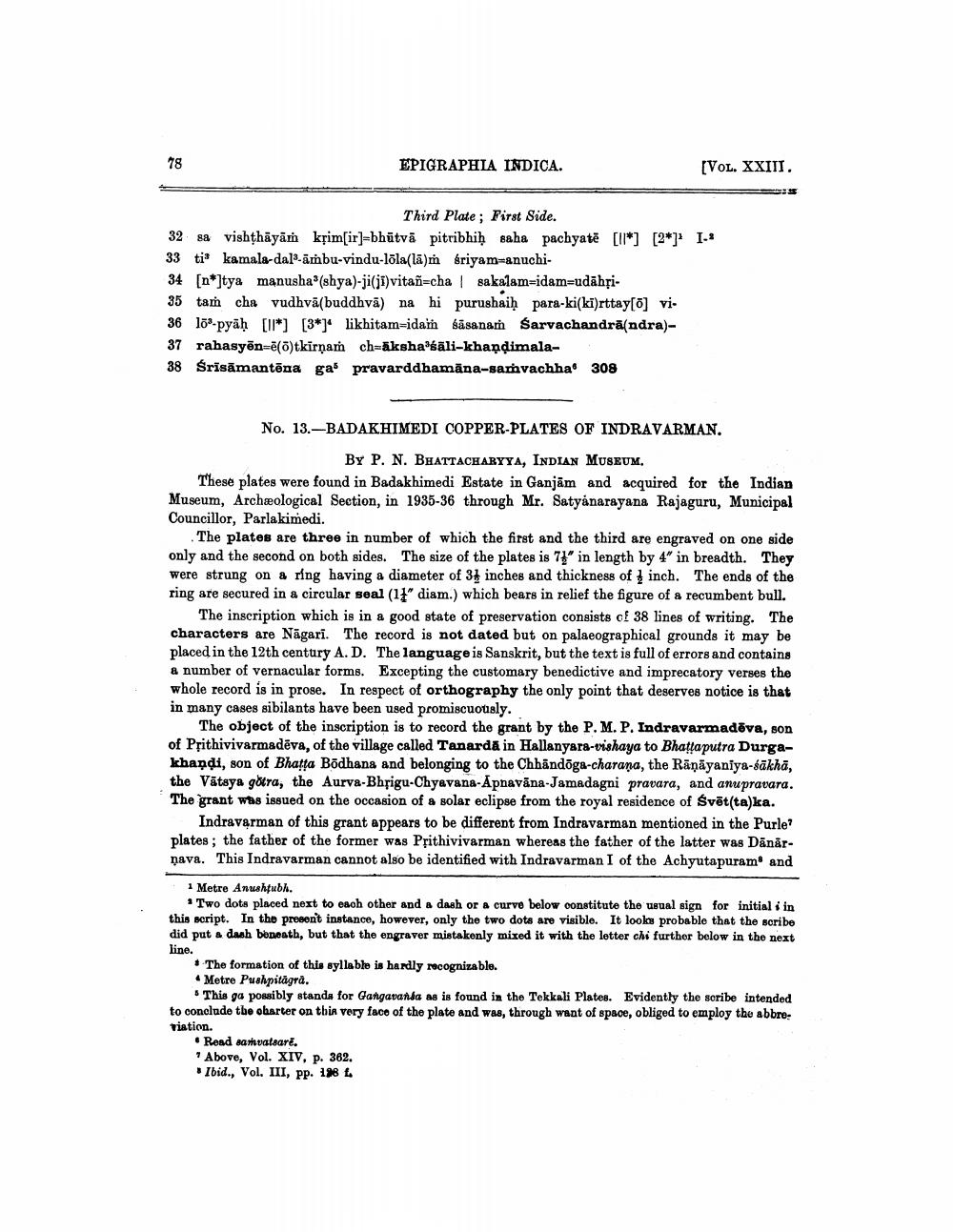________________
EPIGRAPHIA INDICA.
[VOL. XXIII.
Third Plate; First Side. 32 sa vishțhāyām krim[ir]=bhūtvā pitribhiḥ saha pachyatë [118] [2*]* I. 33 ti kamala-dalo-ambu-vindu-lola(lā)ř sriyam-anuchi34 [n*]tya manusha (shya)-ji(ji) vitañ=cha sakalam=idam=udahsi35 tam cha vudhvā(buddhvā) na hi purushaiḥ para-ki(ki)rttay[7] vi36 109-pyäh [11*] [3*j* likhitam=idam sāsanam Sarvachandrāsndra)37 rahasyễn=ē()tkirnam ch=āksha'śāli-khandimala38 Srisämantēna gas pravarddhamāna-samvachha 308
No. 13.-BADAKHIMEDI COPPER-PLATES OF INDRAVARMAN.
BY P. N. BHATTACHARYYA, INDIAN MUSEUM, These plates were found in Badakhimedi Estate in Ganjām and acquired for the Indian Museum, Archæological Section, in 1935-36 through Mr. Satyanarayana Rajaguru, Municipal Councillor, Parlakimedi.
The plates are three in number of which the first and the third are engraved on one side only and the second on both sides. The size of the plates is 7}" in length by 4" in breadth. They were strung on a ring having a diameter of 31 inches and thickness of inch. The ends of the ring are secured in a circular seal (11" diam.) which bears in relief the figure of a recumbent bull.
The inscription which is in a good state of preservation consists of 38 lines of writing. The characters are Nāgari. The record is not dated but on palaeographical grounds it may be placed in the 12th century A.D. The language is Sanskrit, but the text is full of errors and contains a number of vernacular forms. Excepting the customary benedictive and imprecatory verses the whole record is in prose. In respect of orthography the only point that deserves notice is that in many cases sibilants have been used promiscuously.
The object of the inscription is to record the grant by the P. M. P. Indravarmadēva, son of Prithivivarmadēva, of the village called Tanarda in Hallanyara vishaya to Bhattaputra Durgakhandi, son of Bhatta Bödhans and belonging to the Chhändöga-charana, the Rāņāyaniya-sākhā, the Vātaya götra, the Aurva-Bhrigu-Chyavana-Apnavāna-Jamadagni pravara, and anupravara. The grant was issued on the occasion of a solar eclipse from the royal residence of Svēt(ta)ka.
Indravarman of this grant appears to be different from Indravarman mentioned in the Purle? plates; the father of the former was Prithivivarman whereas the father of the latter was Dānárnava. This Indravarman cannot also be identified with Indravarman I of the Achyutapuram and
1 Metre Anushubh.
* Two dota placed next to each other and a dash or a curve below constitute the usual sign for initial i in this script. In the present instance, however, only the two dots are visible. It looks probable that the scribe did put a dash beneath, but that the engraver mistakenly mixed it with the letter chi further below in the next
line.
• The formation of this syllable is hardly recognizable. • Metre Pushpitägra.
This ga possibly stands for Gangavanda as is found in the Tekkali Plates. Evidently the soribe intended to conclude the obarter on this very face of the plate and was, through want of space, obliged to employ the abbreviation.
• Read samvatsare. * Above, Vol. XIV, p. 362.
Ibid., Vol. III, pp. 198 L




